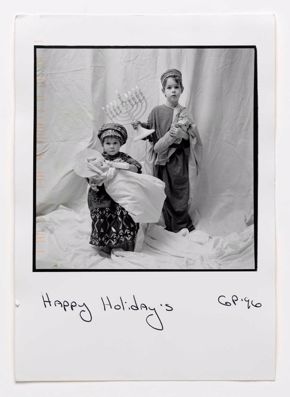Snail Mail: A Conversation with MFAH Curator Anne Tucker (part 3 of 3) May 17, 2012

Greta Pratt, Untitled, 1996, gelatin silver print, the MFAH, gift of the artist.
Robert Frank, Kite, 1984, gelatin silver prints, the MFAH, gift of the artist.
Greta Pratt, Untitled, 1996, gelatin silver print, the MFAH, gift of the artist.
In the wake of the Eastman Kodak Co. filing for bankruptcy, I sat down for a chat with Anne Wilkes Tucker, the Gus and Lyndall Wortham Curator of Photography at the MFAH. Our conversation evolved from the history of a company to how Kodak forever changed the way artists and historians viewed the world. As we talked about the shrinking presence of snapshots in an increasingly digital world, a new MFAH exhibition was going up: Snail Mail, a focused look at photo correspondence. Here, in the third and final excerpt of our conversation, Tucker shares her personal anecdotes behind this age-old visual communication tradition:
"[The objects in] Snail Mail [are from] people who take an original photograph, write a message on the back, and either put it in an envelope or just put it in the mail. I’m not getting nearly as much snail mail—the number of pieces has really diminished. The work on view in Snail Mail ranges from Christmas cards and postcards (Kodak used to sell postcard photographic paper) to photographs that were cut up. Some of them are quite elaborate, where people would mount a photograph on another piece of paper. Keith Carter would take a rejected 16 x 20 photograph, write a message on the back, fold it twice, put it into an 8½ x 11 envelope and send it. Some people would tear a photograph in two and write a message on half of it. Jim Goldberg once put a stamp on an 11 x 14 photograph and put that in the mail, and it of course arrived quite damaged. There are people that send postcards every year or for holidays. There are people who send pictures on a whim.
"We’re mounting [the exhibition] as if it were a big bulletin board in our office. The photos are not matted and framed or anything, they’re just being stuck up on the board. Because they’re not meant to be precious, fine art objects. It’s not heavy-duty, it’s just fun. It’s kind of a footnote about communication: Visual people communicating with another visual person. What distinguishes the show is that every object arrived via US Post. All of these have been sent to the department from artists we have a relationship with, as just a way of staying in touch. Some of them are just quick prints; some are exquisitely made.
"[Now] it’s so different. There was selectivity in what you mailed. Now, when you can post 20 pictures online, it’s different. 'Go to this site and see these pictures' is not the same as, 'I thought you would like this picture.' It’s a different interaction. It sort of puts the responsibility on you to go look it all up, as opposed to that really delightful moment when you open up an envelope and there’s a surprise. It’s different.
"There was a real kind of energy that was being sent to you, whereas now it’s so easy that it’s a whole different phenomenon."





